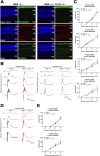Ccrk-Mak/Ick signaling is a ciliary transport regulator essential for retinal photoreceptor survival
- PMID: 39293864
- PMCID: PMC11412320
- DOI: 10.26508/lsa.202402880
Ccrk-Mak/Ick signaling is a ciliary transport regulator essential for retinal photoreceptor survival
Abstract
Primary cilia are microtubule-based sensory organelles whose dysfunction causes ciliopathies in humans. The formation, function, and maintenance of primary cilia depend crucially on intraflagellar transport (IFT); however, the regulatory mechanisms of IFT at ciliary tips are poorly understood. Here, we identified that the ciliopathy kinase Mak is a ciliary tip-localized IFT regulator that cooperatively acts with the ciliopathy kinase Ick, an IFT regulator. Simultaneous disruption of Mak and Ick resulted in loss of photoreceptor ciliary axonemes and severe retinal degeneration. Gene delivery of Ick and pharmacological inhibition of FGF receptors, Ick negative regulators, ameliorated retinal degeneration in Mak -/- mice. We also identified that Ccrk kinase is an upstream activator of Mak and Ick in retinal photoreceptor cells. Furthermore, the overexpression of Mak, Ick, and Ccrk and pharmacological inhibition of FGF receptors suppressed ciliopathy-related phenotypes caused by cytoplasmic dynein inhibition in cultured cells. Collectively, our results show that the Ccrk-Mak/Ick axis is an IFT regulator essential for retinal photoreceptor maintenance and present activation of Ick as a potential therapeutic approach for retinitis pigmentosa caused by MAK mutations.
© 2024 Chaya et al.
Conflict of interest statement
T Chaya and T Furukawa are inventors on a patent application related to this work filed by the Osaka University.
Figures














Similar articles
-
BROMI/TBC1D32 together with CCRK/CDK20 and FAM149B1/JBTS36 contributes to intraflagellar transport turnaround involving ICK/CILK1.Mol Biol Cell. 2022 Aug 1;33(9):ar79. doi: 10.1091/mbc.E22-03-0089. Epub 2022 May 24. Mol Biol Cell. 2022. PMID: 35609210 Free PMC article.
-
Negative regulation of ciliary length by ciliary male germ cell-associated kinase (Mak) is required for retinal photoreceptor survival.Proc Natl Acad Sci U S A. 2010 Dec 28;107(52):22671-6. doi: 10.1073/pnas.1009437108. Epub 2010 Dec 8. Proc Natl Acad Sci U S A. 2010. PMID: 21148103 Free PMC article.
-
ICK is essential for cell type-specific ciliogenesis and the regulation of ciliary transport.EMBO J. 2014 Jun 2;33(11):1227-42. doi: 10.1002/embj.201488175. Epub 2014 May 5. EMBO J. 2014. PMID: 24797473 Free PMC article.
-
Primary cilia biogenesis and associated retinal ciliopathies.Semin Cell Dev Biol. 2021 Feb;110:70-88. doi: 10.1016/j.semcdb.2020.07.013. Epub 2020 Jul 31. Semin Cell Dev Biol. 2021. PMID: 32747192 Free PMC article. Review.
-
The emerging functions of intraflagellar transport 52 in ciliary transport and ciliopathies.Traffic. 2024 Jan;25(1):e12929. doi: 10.1111/tra.12929. Traffic. 2024. PMID: 38272449 Review.
Cited by
-
The intraflagellar transport cycle.Nat Rev Mol Cell Biol. 2025 Mar;26(3):175-192. doi: 10.1038/s41580-024-00797-x. Epub 2024 Nov 13. Nat Rev Mol Cell Biol. 2025. PMID: 39537792 Review.
-
Kinase-dependent regulation of ciliary protein transport and its implications for therapy.Front Mol Biosci. 2025 Jun 25;12:1638737. doi: 10.3389/fmolb.2025.1638737. eCollection 2025. Front Mol Biosci. 2025. PMID: 40636449 Free PMC article. Review.
References
MeSH terms
Substances
LinkOut - more resources
Full Text Sources
Molecular Biology Databases
